Words of wisdom from the Met Office and the BMC.
Our instructors:
Andy Bateman, our company director, is the main guide for Scot Mountain Holidays. He is a qualified winter mountain leader with 15 years experience instructing in the Cairngorms. He says there is nothing like local knowledge for being aware of the avalanche hotspots and how to avoid them. He keeps a very close eye on the weather from this time of year (November) until winter passes towards the end of April and is out on the snowpack so frequently that he has almost as good an eye for predicting the avalanche weaknesses as the SAIS team.
We also work with experienced mountain instructors who deliver mountaineering and climbing courses for us. The instructors live in the area and have in many cases instructed for the RAF outdoor centres when they were based in Grantown on Spey. All instructors who work for us have a wealth of local knowledge.
Winter courses offered by Scot Mountain Holidays
It is essential if you are planning to go out in the hills on your own or even with a small group of friends that you should all have had some formal training in personal safety skills so you know how to use your crampons & ice axe effectively and have all the gear necessary. Navigation is perhaps the least valued of these skills, but arguably the most valuable. We also offer training in winter navigation techniques.
Winter holidays offered by Scot Mountain Holidays (including expeditions)
If you would like to get out in the winter but are not confident of managing on your own, you might want to join an organised group. Take a look at our dates and see if we have anything which will suit your commitments.
USEFUL LINKS
Mountain Weather Information Service
Scottish Avalanche Information Service
So you’re planning a high overnight camp and you’re wondering how warm your winter sleeping bag should be?
Likely Ambient Temperature
With a number of recent TV documentaries ‘laying it on a bit thick’ about how low the temperature can drop in Scotland’s Cairngorm Mountains you might be forgiven for thinking you were heading for somewhere akin to the high Arctic! Indeed the temperature in the Scottish Highlands has been recorded approaching -30 deg C (-27.2 to be precise – the official British record) but this has only been on three occasions in 120 years!
Interestingly, Cairngorm summit (1245m) has only ever managed a record minimum of around half of this at – 16.5 deg C (12th Jan 1987) whilst the residents of nearby Nethybridge (210m) at the foot of the mountain claimed the mercury dropped to -31.3 deg C on 10thJanuary 1982, the same night as one of the -27.2’s was recorded. Satellite evidence suggests they were right!
The vital bit of missing information on these – 30ish lows are that they’ve all been recorded as a result of temperature inversions. That is, cold air has flowed off the mountains and pooled in the valley bottoms where it’s cooled further whilst the mountain summits have remained appreciably warmer. These record minima are in no way a reflection of the likely temperature you would find on our mountains, possibly not surprising considering all our mountains are never that far from a relatively warm sea.
So what would be the likely temperature at the main snow-hole sites, let’s say, in the Cairngorms at around 1100m? Well, the seasonal minimum for 900m is usually around -8 deg C which could, at a pinch, translate to -10 deg C at 1100m but far more often in winter it’s around minus 5 and above. The point is, on our mountains we don’t experience anything like the temperatures you might get in e.g.Norway.
Be guided by advice of sales staff in the shop who should have some relevant experience. Ask for shop expert if your sales person doesn’t demonstrate sufficient knowledge of the range on sale.
Most importatly – buy quality for a sleeping mat. In winter, it is most important to make sure you are insulated from the snow beneath you as you’ll lose the majority of your bodyheat this way.
It goes without saying of course you need to be checking the weather forecasts before you head out. A tented high camp in winter needs to be carefully judged. Those who have got it wrong have ended up having their tent destroyed and gear being scatted far and wide by hurricane force winds.
Andy Bateman 14/11/14
USEFUL LINKS
Mountain Weather Information Service
Scottish Avalanche Information Service
A taster of winter skills, but the only way to really learn how to ice axe arrest is to do it yourself under the guidance of a winter mountain leader or other qualified instructor. Imagine taking a tablet or smartphone out in the snow to try and teach yourself … pretty much a lost cause at the end of the day and you’d be terrified of smashing your technology to pieces. Bit the bullet and book a course.
We found this video on YouTube, produced by the MCofS. Here Roger Wild introduces ice axe arrest and explains the basics which you’d learn on the hill with Andy (lead instructor with Scot Mountain Holidays). If you’re comtemplating a winter skills weekend, bear in mind that this is one of the core skills you’ll be learning, which many people have heard about before they book a skills weekend; however, as Roger Wild says: there’s a lot more to the full range of skills to keep you safe in winter and you should consider ice axe arrest to be the last in a series of skills aimed at preventing a sliding fall.
Check out our Top Ten Winter Skills tips: https://scotmountainholidays.com/blog/top-10-winter-skills-tips/
(A synopsis in pictures)
The snow’s back here in the Cairngorms and it’s only 4th November 2014 – plenty of time for the snow to build up for a fabulous Christmas and New Year in the Highlands. Take a look at our selection of winter images below – all taken in during winter seasons in the Cairngorms. Will it be an official white Christmas or just white on the high peaks of the Cairngorms
Photo caption: A day out in the snow – heading home in the sunset,
turning the snow pink and giving life to the Cairngorms –
also known as Mhonaidh Ruaidh (the red hills).
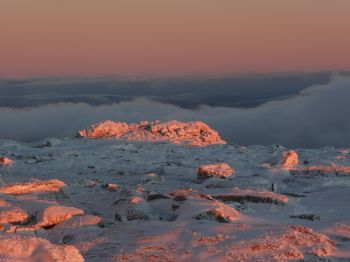
Photo caption: Sometimes a wee bit of cloud can play into your hands
and produce a much more stunning picture than a clear blue sky,
especially in the soft winter light we get here in the Cairngorms,
which is of course enhanced by reflection on the snow.
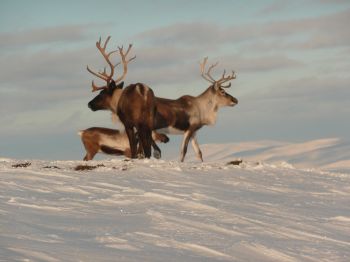
Photo caption: Unique to the Cairngorms National Park,
Britain’s only reindeer herd, which are free-roaming
across the hills in the winter. You could bump into them
on any of our courses or winter walking holidays.
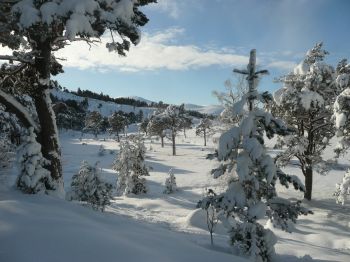
Photo caption: White Christmas? Wouldn’t that be amazing?
This is the kind of snow laden scene
we’d all like to see, but how many of you would like to
experience it yourselves? When the snow lay round about,
deep and crisp and even …
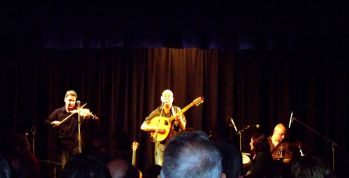
Photo caption: It’s New Year and it’s Scotland – must mean it’s time for a party –
or as you’re in Scotland let’s give it the proper name and join the ceilidh!
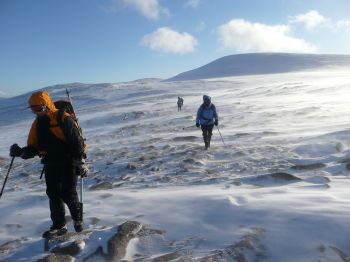
Photo caption: Winter walking holiday across the Cairngorm plateau. Check out the blue skies!
Inspired? Check out some of our winter offerings in the Cairngorms and further afield across the Highlands of Scotland
Most Scots don’t question the origins of Hogmanay, just as you wouldn’t question the traditions associated with any of your big national celebrations such as Thanksgiving, or Christmas, or Easter. I’m sure a lot of kids in the local schools would be hard pushed to tell you why Hogmanay is such a big deal; so much so that all Scots have an extra bank holiday at the beginning of the year that the English don’t get.
Hogmanay – as a word – is said to have either French or Norse roots. There is some confusion and argument as to which of these influences has the strongest claim to being the root of the word. The French word means the act of giving a gift to bring in the New Year or the children’s tradition of asking for sweets or small treats to bring in the New Year – a bit like trick or treating at Halloween.
Many of the traditions though are associated with ancient fesivals like the Gaelic “Samhain” (which also has close ties to Halloween as it marks the end of the harvest and the beginning of winter) and the winter solstice.
Of course any cause for celebration here in the Western Hemisphere and we break out the alcohol and dance!
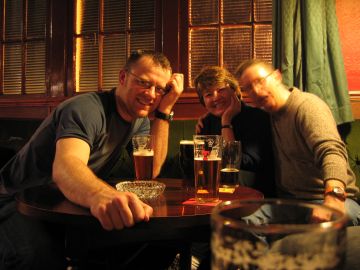
When Protestantism under John Knox was gaining support in Scotland, it was turbulent times across the whole of Britain. Catholicism was under attack and the festivities of Christmas were seen by Knox as a very Catholic tradition and as such despised. He moved to abolish the celebration of Christmas in Scotland as being too Catholic by far.
Of course this did not mean that the celebration went away completely, it was just transferred somewhat over to New Year. After all, everyone needs a reason to celebrate something in the depths of winter.
There are many traditions related to Christmas in England and the rest of the continent that are only visited once a year at Christmas time. Many wonder why – for example, why are brussel sprouts so strongly associated with Christmas? Watch this hilarious video from Michael Mcintyre about his interpretation of Christmas traditions.
Nowadays we have reason to thank John Knox as his ban has meant that in Scotland we get an additional public holiday to bring in the New Year and the differing traditions associated with Hogmanay bring many a visitor to Scotland:
In Edinburgh they have one of the biggest street parties in the world with an amazing firework celebration which has been in the Guiness Book of Records.
In Stonehaven, there is a fireball parade.
Across the country people visit each other from midnight onwards to “first foot”. It brings good luck for the year for a visitor to be asked in on New Year’s Day. You should take a piece of coal, whisky and black bun i.e. food, drink and warmth/comfort.
Here at Fraoch Lodge we head out into the snow and bring the New Year in with a walk across the high peaks of the Cairngorms using all the cramponing and ice axe techniques learnt during our guests stay leading up to New Year’s Day.
Funny though – when you look through the other images on Flickr no one else seems to think about New Year celebrations in quite the same way!
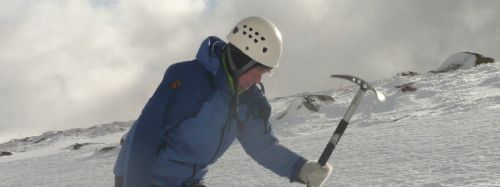
Reference:
The Great British Bake Off explains Hogmanay food
All content © Copyright Scot Mountain Holidays 2025
Responsive web design by Summit Web Solutions